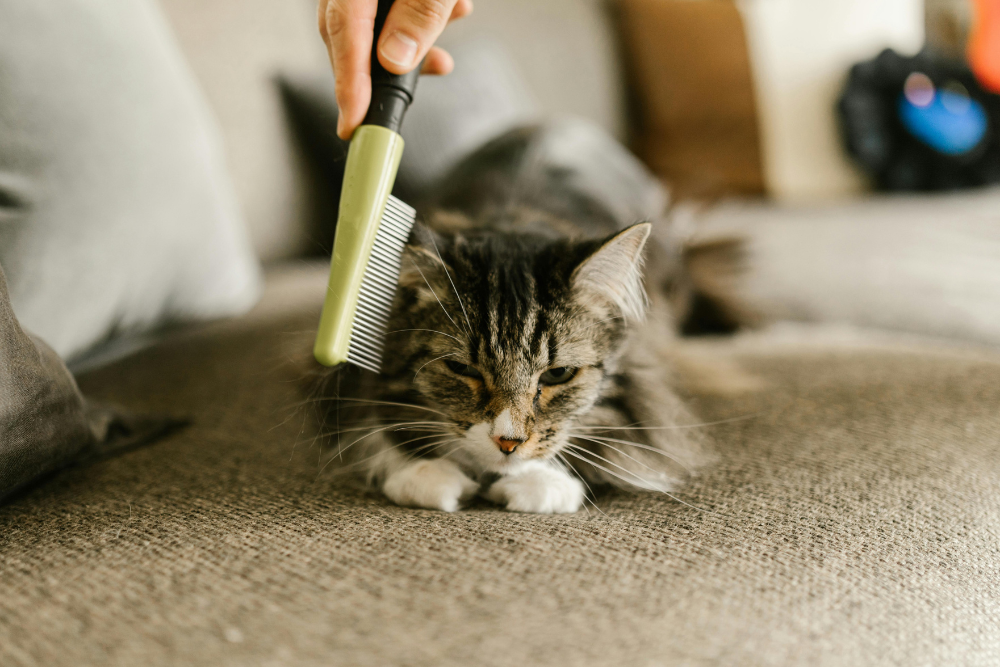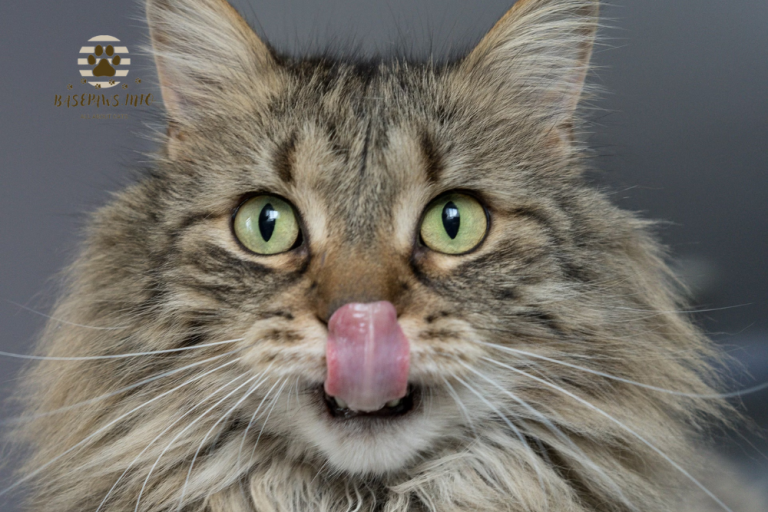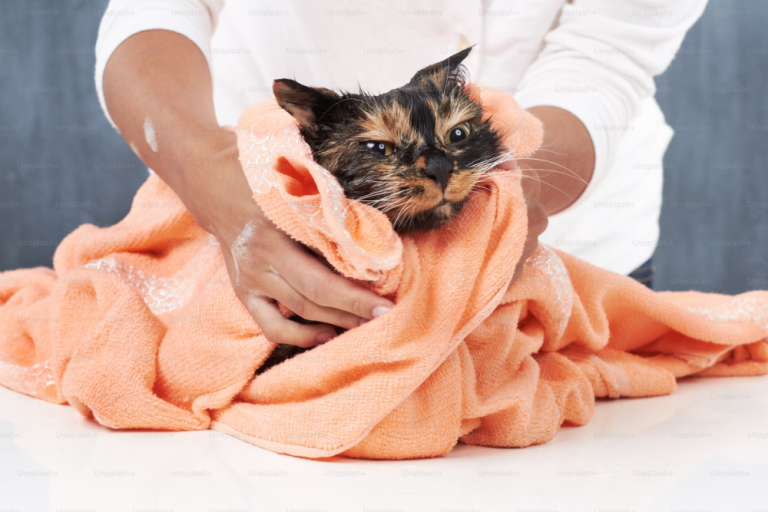The Ultimate Guide to Cat Grooming: Keep Your Cat Happy and Healthy
Is your cat’s fur starting to look matted or shedding uncontrollably? Are you tired of dealing with hairballs and wondering if your cat grooming habits are enough to keep them healthy? You’re not alone. Many cat owners struggle with the balance between letting their feline friends groom themselves and knowing when to step in.
While cats are known for being excellent at self-grooming, sometimes they need a little extra help. Regular grooming not only keeps your cat’s coat looking great but also helps prevent common issues like hairballs, matting, and skin problems. In this guide, we’ll walk you through everything you need to know about grooming your cat—from how to help them groom at different life stages to tips for handling aggressive cats during grooming.
Why Cats Need Grooming
Preventing Hairballs and Fur Mats
Cats naturally shed their fur, and while grooming, they tend to swallow loose hairs. Over time, this can lead to the formation of hairballs, which are uncomfortable for your cat to cough up and annoying for you to clean up. While hairballs are common, excessive grooming or lack of proper care can exacerbate the issue.
Fur mats can be another big issue, particularly for long-haired cats. Without regular brushing, a cat’s fur can become tangled and matted, which can pull painfully at their skin. Mats can cause skin irritations and may even lead to infections if left untreated. Regular brushing helps prevent both hairballs and mats, keeping your cat’s fur in top shape.
Daily Grooming Tip
Spend 5-10 minutes each day brushing your cat, especially during shedding seasons. This can help reduce hairballs and keep your cat’s fur looking smooth and healthy.
Health and Behavioral Benefits
Regular grooming has physical health benefits beyond just a pretty coat. Brushing your cat stimulates their circulation, improving blood flow, and can help keep their skin and muscles healthy. Grooming also helps distribute your cat’s natural oils, which are essential for waterproofing and protecting the skin and coat. This daily grooming routine mimics the natural behavior your cat would do on its own, but with an added layer of thoroughness.
Beyond health, grooming can positively impact your cat’s behavior. A well-groomed cat is often more content and less likely to exhibit signs of stress or anxiety. Cats are clean animals by nature, and helping them stay clean reinforces a positive environment. You’ll notice your cat becoming calmer and possibly more affectionate after regular grooming sessions.
How Cats Groom Themselves
Natural Grooming Process
Cats are meticulous groomers, using their rough tongues to remove loose fur, dirt, and debris from their coats. Their tongues are covered with tiny, hook-like structures called papillae that act like natural brushes, helping them maintain their sleek appearance. You may notice your cat grooming several times a day, especially after eating or waking up from a nap.
While this natural grooming process is effective, it isn’t foolproof. Long-haired cats often miss spots, and older or overweight cats may have difficulty reaching certain areas of their bodies. Regular brushing from you ensures that your cat’s coat remains clean and free from tangles.
Grooming Fact: Cats Groom to Regulate Temperature
Did you know that in hot weather, the saliva cats spread during grooming helps to cool them down? Grooming plays a role in thermoregulation, making it even more essential during warmer months.
Assisting with Cat Grooming
Grooming at Different Life Stages
Kittens are naturally curious and love exploring their surroundings, which often leads them into dirty situations. While young cats will attempt to groom themselves, they benefit from a little extra help as they learn the ropes. Grooming your kitten regularly helps create a routine and strengthens the bond between you.
For adult cats, grooming maintains their health and keeps their coats shiny and smooth. Adult cats may need less frequent grooming compared to kittens, but regular brushing will help prevent matting and reduce shedding.
Senior cats often have difficulty reaching certain areas due to stiffness or arthritis, making it important to step in and assist. Older cats may also develop dry skin, so gentle grooming can help spread natural oils and keep their skin hydrated.
| Cat’s Age | Grooming Frequency | Tools Needed |
| Kittens | Weekly | Soft brush, comb |
| Adult Cats | Every other week | Bristle brush, nail clippers |
| Senior Cats | Weekly | Wide-tooth comb, gentle brush |
Tools and Techniques for Brushing, Nail Trimming, and More
To groom your cat effectively, you need the right tools. Here’s a breakdown of what you’ll need based on your cat’s coat type:
- Short-haired cats: Use a bristle brush or rubber grooming mitt. These tools are gentle and help remove loose fur.
- Long-haired cats: Use a wide-tooth comb or slicker brush to detangle and remove mats. Pay extra attention to the undercoat, where tangles often form.
Nail Trimming Tips:
- Trim your cat’s nails every 2-3 weeks to prevent overgrowth and scratching. Use cat-specific nail clippers and always be cautious of the quick (the pink part of the nail that contains nerves and blood vessels).
Brushing Checklist:
- Soft brush or wide-tooth comb
- Nail clippers
- Cat-safe toothbrush
- Ear cleaner (for long-haired breeds prone to ear buildup)
The Professional Grooming Experience
What to Expect During a Cat Grooming Session
Taking your cat to a professional groomer can be a great option, especially for long-haired or senior cats. Groomers offer services such as bathing, nail trimming, ear cleaning, and thorough brushing.
When you first arrive, the groomer will assess your cat’s coat and ask about any specific issues (such as matting or skin conditions). They will then create a personalized grooming plan based on your cat’s needs.
Key Grooming Services: Bathing, Brushing, Nail Care
- Bathing: While most cats don’t require frequent baths, long-haired or outdoor cats may benefit from occasional bathing to remove dirt and debris. Professional groomers use cat-safe shampoos that are gentle on the skin.
- Brushing: Groomers ensure that all tangles and mats are removed, leaving your cat’s coat smooth and shiny.
- Nail Care: Trimming a cat’s nails can be tricky, but professional groomers are skilled at keeping your cat calm during the process. Regular nail trims prevent overgrowth and protect your furniture from scratches.
- Ear Cleaning: Groomers will check your cat’s ears for any signs of wax buildup, infections, or mites and clean them using cat-safe solutions.
Handling Aggressive or Stressed Cats
Tips for Grooming Difficult Cats
Some cats become anxious or aggressive during grooming, making the process more challenging. If your cat exhibits these behaviors, consider starting with short, gentle grooming sessions to build their tolerance. Offering treats or using calming sprays like Feliway can help create a more relaxing environment.
For particularly difficult cats, protective gear such as Kevlar gloves or sleeves can prevent injuries during grooming. If your cat becomes too stressed, it’s best to stop and try again later.
Safety Precautions and Preventing Cat Bites
Cat bites can be dangerous, as they often lead to infections due to bacteria in a cat’s mouth. Always assess your cat’s mood before starting a grooming session. If your cat shows signs of aggression (growling, hissing, or swatting), give them some space and try again later.
If you are unsure about handling an aggressive cat, consult with a professional groomer who can help.
Common Grooming Issues
Why Cats Overgroom: Causes and Solutions
Overgrooming is a sign that something may be wrong with your cat. Stress, anxiety, allergies, or skin irritations can cause your cat to lick or groom themselves excessively. Over time, this can lead to bald patches, sores, or hair loss.
If you notice overgrooming, it’s important to consult with a vet to rule out underlying health problems. You can also reduce your cat’s stress by maintaining a consistent routine and providing them with plenty of mental and physical stimulation.
Managing Shedding and Allergies
Shedding can be a nuisance, especially for cat owners with allergies. Regular grooming not only reduces shedding but also helps lower the amount of dander in your home. If you or someone in your household suffers from allergies, brushing your cat daily can make a big difference.
Here are some additional tips for managing shedding:
- Brush your cat daily during shedding seasons (spring and fall).
- Use a de-shedding tool for long-haired cats to remove loose fur.
- Bathe your cat every few months if they are prone to excessive shedding.
Becoming a Cat Groomer
Certification and Career Opportunities
If you love working with cats, becoming a professional groomer might be the right career path for you. Cat grooming requires specialized training, including understanding feline behavior, learning grooming techniques, and mastering the tools of the trade.
Certification programs are available through various pet grooming schools and associations. These programs typically cover topics such as:
- Cat anatomy and coat types
- Safe handling and restraint techniques
- Identifying and addressing common skin conditions
- Business management and client communication
Once certified, you can work as a freelance groomer, start your own grooming business, or join a grooming salon. The demand for skilled pet groomers is growing, making it a lucrative and rewarding career for animal lovers.
Cat grooming is an essential part of your pet’s overall health and happiness. Regular grooming prevents common problems like hairballs, mats, and shedding, while also strengthening the bond between you and your cat. Whether you choose to groom your cat at home or take them to a professional, the key is consistency and using the right techniques.
By incorporating grooming into your cat’s daily routine, you’ll ensure they look and feel their best—keeping them healthy and content for years to come.
So, grab your brush, set aside some time, and enjoy the benefits of a clean, happy, and healthy cat!
Remember: Regular grooming not only keeps your cat looking great but also improves their health and behavior. Start grooming early, use the right tools, and seek professional help if needed.
Happy grooming!







